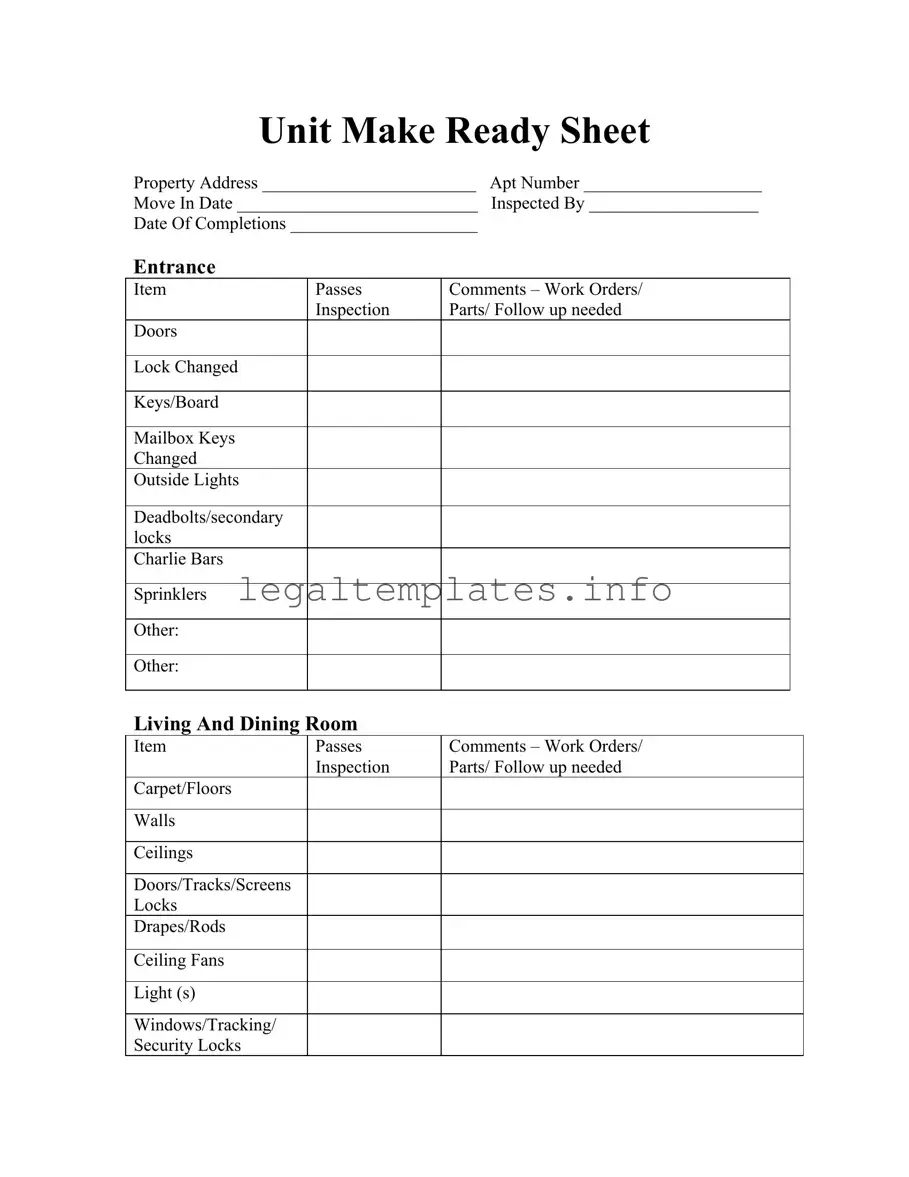What is a Make Ready Checklist?
A Make Ready Checklist is a detailed form used by property managers and landlords to ensure a rental unit is ready for a new tenant. It covers various items in the apartment, including the entrance, living areas, kitchen, bedrooms, hallways, and bathroom, assessing their condition and noting any work orders, inspections, parts, or follow-up needed. The checklist aims to ensure the rental unit meets specific standards before a tenant moves in.
What items are included in the checklist for the entrance?
The entrance section of the checklist reviews items such as door locks, keys, mailbox keys, outdoor lights, deadbolts, secondary locks, and any necessary work related to sprinklers or other specified aspects to ensure safety and functionality.
How detailed is the checklist when it comes to living and dining room areas?
For the living and dining areas, the checklist encompasses a thorough inspection of carpets, floors, walls, ceilings, doors, locks, drapes, rods, ceiling fans, light fixtures, windows, and patio doors. It evaluates each for their condition, requiring notes on any tasks or fixes that need attention.
What kitchen items does the checklist cover?
In the kitchen, the checklist scrutinizes appliances such as the stove, oven, and refrigerator, as well as the dishwasher, sink, and disposal unit for functionality and leaks. It also reviews the kitchen’s moisture conditions, cabinets, counter, lighting, and vents to ensure everything is in working order.
Are bedrooms inspected in detail by the Make Ready Checklist?
Yes, bedrooms receive detailed inspections on the checklist, which covers walls, ceilings, carpets, floors, doors, windows, window treatments, lighting, outlets, closets, doors, and air conditioning vents to guarantee comfort and safety.
What does the checklist look for in hallways?
The checklist examines hallways for the condition of air handlers, air filters, smoke alarms, floors, walls, closets, doors, and lighting. It emphasizes maintaining safety features such as fire extinguishers and smoke alarms.
How comprehensive is the bathroom section of the Make Ready Checklist?
The bathroom section is very comprehensive, focusing on walls, ceilings, floors, plumbing fixtures, cabinets, ventilation, and lighting. It also includes an inspection for mold, mildew, and leaks, ensuring that bathroom fixtures like towel bars and shower rods are in place and functional.
Is there a follow-up process mentioned in the Make Ready Checklist?
While the checklist itself primarily focuses on the condition and readiness of various items in the unit, notes regarding work orders, inspections, parts, or follow-up needs are encouraged throughout. This suggests a process where identified issues are addressed promptly, though the specifics of follow-up processes may vary between properties.
Who is responsible for completing the Make Ready Checklist?
Typically, the property manager, maintenance team, or landlord is responsible for completing the Make Ready Checklist. It may also be inspected by a designated representative to ensure all standards are met before the tenant moves in.
What is the importance of having a Make Ready Checklist completed before a tenant moves in?
Completing a Make Ready Checklist before a tenant moves in is crucial for ensuring that the rental unit is in a safe, clean, and fully functional condition. It helps identify any repairs or maintenance needed, streamlines the move-in process, and enhances tenant satisfaction by delivering a welcoming and liveable space from day one.
